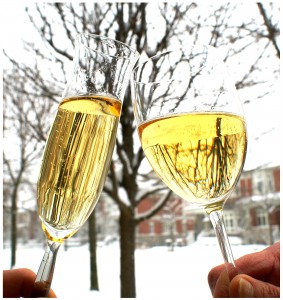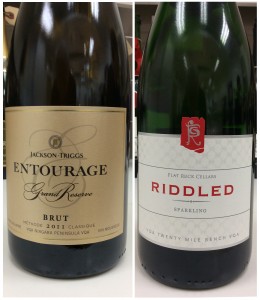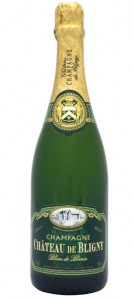These seven sparkling wines combine great value and quality from the LCBO’s new releases.

Try pouring your sparkling into a tulip shaped white wine glass to discover the world of aromas that it opens up to you.
I like to drink sparkling wine all year round. And I don’t think it’s just an “occasion” or “holiday” wine either, although the approaching Christmas season brings with it an interesting selection of additional sparkling wines at our local LCBO stores.
Sparkling wines can serve as an invigorating apéritif — a sipping wine when lounging with friends, or standing in a party setting. But depending on the wine, they can also pair with all manner of food: oysters and other shellfish, poultry, lighter meats, cheeses, and of course salty snacks like popcorn, cheezies, chips and nuts. And by the way, if your friends and guests think that sparkling wine is for special occasions, isn’t opening a bottle when they arrive on any “regular” occasion just going to make them feel special?
Before we look at the wines themselves, keep in mind that you don’t need special glasses for sparkling wine. While Champagne flutes look very elegant, and have the benefit of showing off the bubbles as they travel up the length of the flute, they don’t showcase the wonderful aromas of the wine, and for me that’s one of the highlights. These days, serious tasters use good white wine glasses, with the regular tulip shape that collects the aromas and allows you to enjoy them at leisure.
Here are some of my favourite new LCBO releases at various prices and from various places, roughly ordered by price.
 Sparkling wines from France that are not from the Champagne region are usually labeled as “Crémant” and here is one from Alsace: Pierre Sparr Brut Rosé Crémant d’Alsace, AC Alsace, ($17.95 LCBO #39016, 12.5% alcohol).
Sparkling wines from France that are not from the Champagne region are usually labeled as “Crémant” and here is one from Alsace: Pierre Sparr Brut Rosé Crémant d’Alsace, AC Alsace, ($17.95 LCBO #39016, 12.5% alcohol).
This is a non-vintage wine that can vary from release to release. This version is light salmon in colour, with an intense, lifted almost medicinal floral nose, accompanied by notes of strawberries, raspberries and lemons. There is crisp acidity on the palate, with pleasant fruit and just a hint of toast. The finish is quite long and fresh. Simple, pleasant and clean. (88).
Cava, sparkling wine from Spain, is often an excellent value. Two standards that are widely available throughout the year, the Freixenet Cordon Negro Brut Cava (LCBO# 216945, currently $12.95) and the Segura Viudas Brut Reserva Cava (LCBO #216960, currently $14.25) are great values. But why not step up several notches in quality and for about $6.00 more you can try the Freixenet Elyssia Gran Cuvée Brut Cava, DO Cava, Penedès, Spain ($19.95, Vintages #392548, 12% alcohol).
The wine is very light yellow, with a bright nose that suggests white flowers, lemons, yellow apples, white peach and toast. The wine is brut, but has a touch of residual sugar that balances the crisp acidity, with richness on the palate that carries the floral and fruit notes through to a surprisingly long finish. Excellent value. (89)
Tasmania is excelling in the production of cool climate wines, and sparkling wine is an important part of that movement. A good example is the 2008 Josef Chromy Sparkling, Méthode Traditionnelle, Tasmania ($29.95, Vintages #393629, 12.1% alcohol).
The wine pours light yellow, showing fine bubbles. The nose is vibrant, suggesting sweet brioche, black currant leaf, lemon zest, green apple, and an interesting hint of spearmint. The wine is brut, with elevated acidity, some richness, and more fruit on the palate than suggested by the nose: lively green apple, lemon and toasty notes, with a firm citrus and mineral finish. Very good. (90)
 Canadian sparkling is quite a big deal these days, and you can find a wide variation in style and quality. Here are two well-priced traditional method offerings that make the seasonal list at Vintages
Canadian sparkling is quite a big deal these days, and you can find a wide variation in style and quality. Here are two well-priced traditional method offerings that make the seasonal list at Vintages
2011 Jackson-Triggs Entourage Grand Reserve Brut, VQA Niagara Peninsula ($22.95, Vintages #234161, 12% alcohol).
The wine is very light yellow, showing medium bubbles. The nose is quite intense, with lifted white flowers and peach blossoms, and crisp lemon and white peach notes. The wine is brut, with a pleasant suggestion of residual sugar, balanced by crisp acidity that keeps the palate fresh and light. (89)
2009 Flat Rock Cellars Riddled Sparkling, VQA Niagara Peninsula ($29.95, Vintages #383315, 12.3% alcohol).
The wine is medium yellow; and on the nose I found crisp lemon, red apple and white flowers, with some toast and bready notes. The wine is brut, with a suggestion of sweetness, and firm acidity and some richness. The fruit, flowers and toasty notes reappear on the palate, and finish with a satisfying acidity. Always dependable, and available from the winery throughout the year. This is the only screw cap sparkling on my list. (89)
To my mind, the stars of this release are the Champagnes. They are all very good, and remind us why Champagne is still the leader in sparkling wine quality. No doubt the prices begin at a significantly higher level, but I would still contend that there is some real value here. Both of my selections are classified as Récoltant Manipulant (RM), smaller growers who produce their own wine, as opposed to the larger houses who are Négociant Manipulant (NM), which means that they purchase grapes to produce the wine.
Delouvin-Bagnost Tradition Brut Champagne, Champagne AC, non-vintage ($47.95, Vintages #385369, 12% alcohol)
The wine is medium yellow, and has fine bubbles. The nose is quite lively, and has a floral lift, but for me the dominant aroma was slightly bruised yellow apple. The wine is brut, with some softness that indicates a little residual sugar. The wine is rich, broad, with mouth-filling bruised apple, lemon and lots of toast, brioche and honey. The finish is long. Very good wine, highly appealing. (92).
 Château De Bligny Blanc de Blancs Champagne, Champagne AC, non-vintage ($49.95, Vintages #385112, 12% alcohol).
Château De Bligny Blanc de Blancs Champagne, Champagne AC, non-vintage ($49.95, Vintages #385112, 12% alcohol).
Blanc de Blanc means that this is made from Chardonnay. The wine is light yellow, and shows a very fine mousse. The nose is very intense, and suggests sweet ripe yellow apples, not quite bruised but reminiscent of Tarte Tatin, fresh lemon juice and zest, yellow pears, and a cornucopia of toast, brioche, hazelnuts and sweet white chocolate — complex and captivating. The wine is brut, with the merest hint of sweetness, and adding to the rich fruit and other flavours there is real minerality. Rich, but still fresh and lively on the finish. This is a terrific wine for the price. (92+)
One of the things with Champagne is that you can keep spending more and more. To be sure, some of that (maybe a lot of that) is solid branding and marketing from the big Champagne houses, but not always. If I were going to take another giant step up the price ladder, the new release I would choose is the Moët & Chandon 2004 Grand Vintage Brut Champagne, Champagne AC ($84.95, Vintages #69773, 12% alcohol). This is brilliant stuff — bone dry, complex, crisp yet creamy — a world of experience in your glass.
NB: A version of this article can also be found on Tim’s website, Wine Discovery.

Leave a Reply